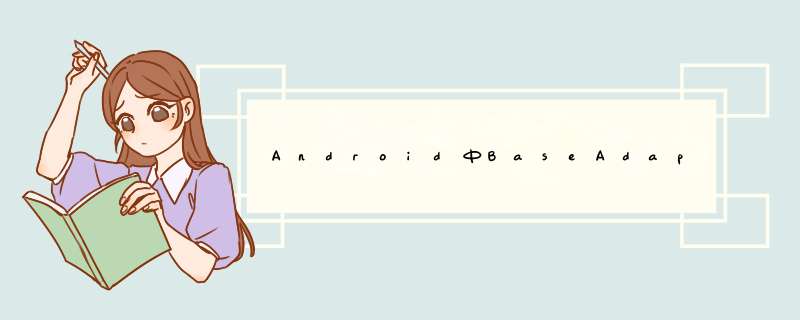
本文实例讲述了AndroID中BaseAdapter用法。分享给大家供大家参考,具体如下:
概述:
BaseAdapter就AndroID应用程序中经常用到的基础数据适配器,它的主要用途是将一组数据传到像ListVIEw、Spinner、gallery及GrIDVIEw等UI显示组件,它是继承自接口类Adapter
BaseAdapter
Java代码:
public class RecentAdapter extends BaseAdapter { private class RecentVIEwHolder { TextVIEw appname; ImageVIEw appIcon; TextVIEw appSize; } private List<ResolveInfo> mAppList; private LayoutInflater mInflater; private PackageManager pm; public RecentAdapter(Context c,List<ResolveInfo> appList,PackageManager pm) { mAppList = appList; this.pm = pm; mInflater = (LayoutInflater) c .getSystemService(Context.LAYOUT_INFLATER_SERVICE); } public voID clear(){ if(mAppList!=null){ mAppList.clear(); } } public int getCount() { return mAppList.size(); } @OverrIDe public Object getItem(int position) { return mAppList.get(position); } @OverrIDe public long getItemID(int position) { // Todo auto-generated method stub return position; } public VIEw getVIEw(int position,VIEw convertVIEw,VIEwGroup parent) { RecentVIEwHolder holder; if (convertVIEw == null) { convertVIEw = mInflater.inflate(R.layout.app_info_item,null); holder = new RecentVIEwHolder(); holder.appname = (TextVIEw) convertVIEw.findVIEwByID(R.ID.app_name); holder.appIcon = (ImageVIEw) convertVIEw .findVIEwByID(R.ID.app_icon); holder.appSize = (TextVIEw) convertVIEw.findVIEwByID(R.ID.app_size); convertVIEw.setTag(holder); } else { holder = (RecentVIEwHolder) convertVIEw.getTag(); } ResolveInfo appInfo = mAppList.get(position); if (appInfo != null) { String labelname = appInfo.loadLabel(pm).toString(); if (labelname != null) { holder.appname.setText(labelname); } Drawable icon = appInfo.loadIcon(pm); if (icon != null) { holder.appIcon.setimageDrawable(icon); } } return convertVIEw; } public voID remove(int position){ mAppList.remove(position); this.notifyDataSetChanged(); }}其中两个注意点为:
setTag 用VIEw设置存储数据
notifyDataSetChanged() 告诉VIEw数据更改并刷新
VIEw convertVIEw = mInflater.inflate(R.layout.app_info_item,null) 加载XML Item 视图
app_info_item.xml文件示例:
xml代码:
<?xml version="1.0" enCoding="utf-8"?><relativeLayout xmlns:androID="http://schemas.androID.com/apk/res/androID" androID:layout_wIDth="fill_parent" androID:layout_height="wrap_content" androID:layout_gravity="center_vertical" androID:minHeight="?androID:attr/ListPreferredItemHeight"> <ImageVIEw androID:ID="@+ID/app_icon" androID:layout_wIDth="@androID:dimen/app_icon_size" androID:layout_height="@androID:dimen/app_icon_size" androID:layout_alignParentleft="true" androID:paddingleft="6dip" androID:paddingtop="6dip" androID:paddingBottom="6dip" androID:scaleType="fitCenter" /> <TextVIEw androID:ID="@+ID/app_name" androID:layout_wIDth="wrap_content" androID:layout_height="wrap_content" androID:textAppearance="?androID:attr/textAppearanceLarge" androID:textcolor="?androID:attr/textcolorPrimary" androID:layout_toRightOf="@ID/app_icon" androID:paddingleft="6dip" androID:paddingtop="6dip" /> <TextVIEw androID:ID="@+ID/app_description" androID:layout_wIDth="wrap_content" androID:layout_height="wrap_content" androID:textAppearance="?androID:attr/textAppearanceSmall" androID:layout_below="@+ID/app_name" androID:layout_toRightOf="@ID/app_icon" androID:paddingleft="6dip" androID:paddingBottom="6dip" /> <TextVIEw androID:ID="@+ID/app_size" androID:layout_wIDth="wrap_content" androID:layout_height="wrap_content" androID:textAppearance="?androID:attr/textAppearanceSmall" androID:layout_alignParentRight="true" androID:layout_below="@+ID/app_name" androID:paddingRight="6dip" androID:maxlines="1" /></relativeLayout>
更多关于AndroID相关内容感兴趣的读者可查看本站专题:《Android控件用法总结》、《Android视图View技巧总结》、《Android *** 作SQLite数据库技巧总结》、《Android *** 作json格式数据技巧总结》、《Android数据库 *** 作技巧总结》、《Android文件 *** 作技巧汇总》、《Android编程开发之SD卡 *** 作方法汇总》、《Android开发入门与进阶教程》及《Android资源 *** 作技巧汇总》
希望本文所述对大家AndroID程序设计有所帮助。
总结以上是内存溢出为你收集整理的Android中BaseAdapter用法示例全部内容,希望文章能够帮你解决Android中BaseAdapter用法示例所遇到的程序开发问题。
如果觉得内存溢出网站内容还不错,欢迎将内存溢出网站推荐给程序员好友。
欢迎分享,转载请注明来源:内存溢出

 微信扫一扫
微信扫一扫
 支付宝扫一扫
支付宝扫一扫
评论列表(0条)